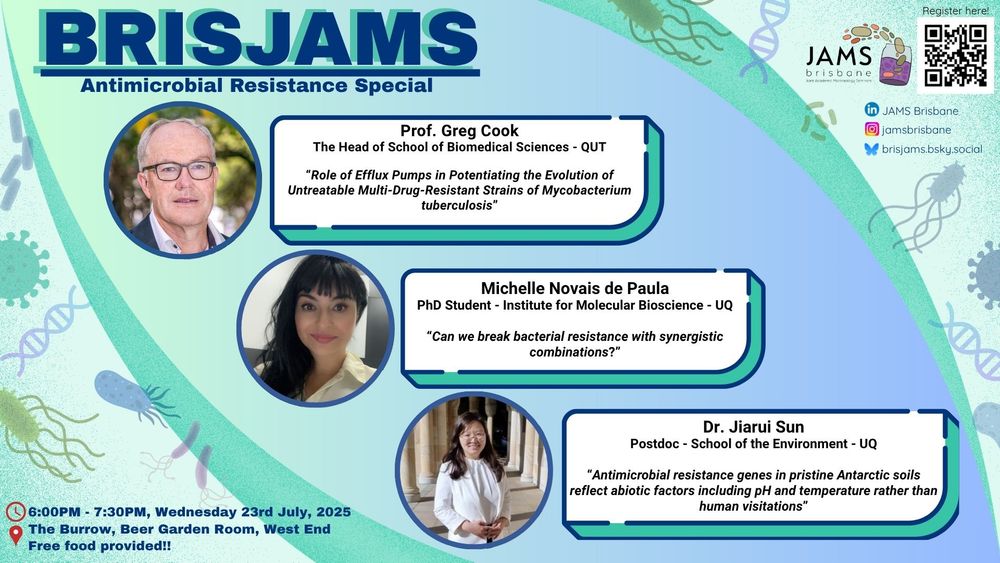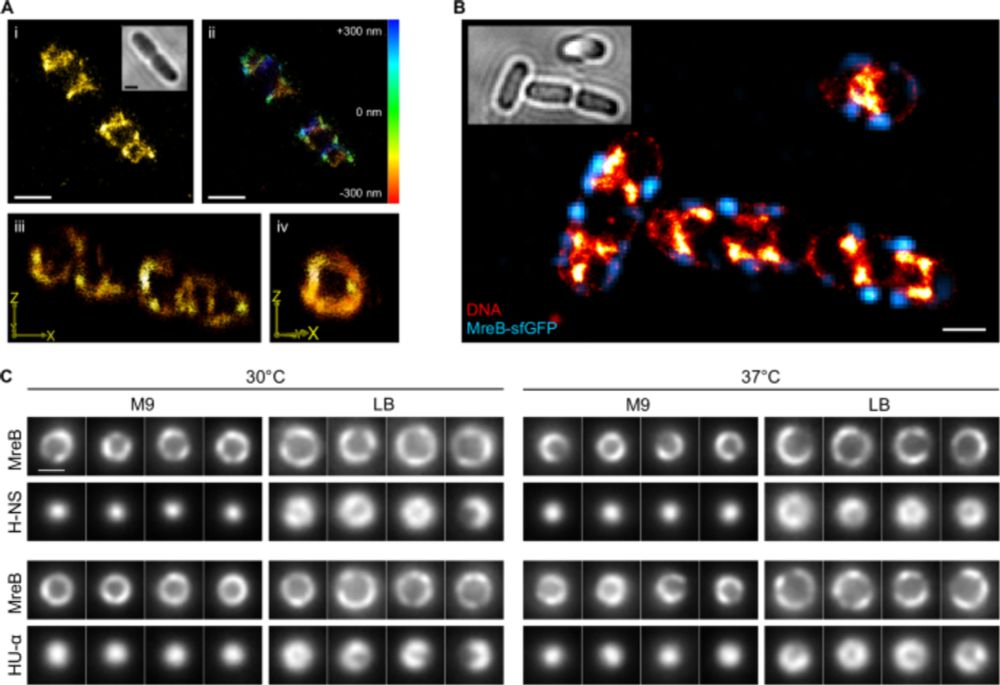Studying bacterial pathogenesis, AMR & antimicrobial development.
Research fellow @ Institute for Molecular Bioscience, UQ
Previously Postdoc @Dunn School of Pathology, University of Oxford.
PhD @The Australian National University
Social Media Officer- @sentanuka.bsky.social 😊 🔬 🦠 🧫 🧪

www.nature.com/articles/s41...


Read more in the eLife Insight Article: buff.ly/1mIc6m0

Read more in the eLife Insight Article: buff.ly/1mIc6m0
Join BrisJAMS and Australian Society of Microbiology Qld Branch, this November for an inspiring evening of stories, insights, and real-world advice from scientists who’ve successfully built careers outside the academic path!🌟
6 November 2025, 6:00 PM – 8:00 PM

Join BrisJAMS and Australian Society of Microbiology Qld Branch, this November for an inspiring evening of stories, insights, and real-world advice from scientists who’ve successfully built careers outside the academic path!🌟
6 November 2025, 6:00 PM – 8:00 PM
@sydneylmiles.bsky.social @katholt.bsky.social
🙏to transformative collaborative effort
www.nature.com/articles/s41...
@sydneylmiles.bsky.social @katholt.bsky.social
🙏to transformative collaborative effort
www.nature.com/articles/s41...
🔬💡🧫🙌 😎 😁
#MicrobiologyForAll #BacterialInfections #ViralPhylogeny #AntibioticDevelopment #Biofilms #Microbiology2025 #jamsbrisbane




🔬💡🧫🙌 😎 😁
#MicrobiologyForAll #BacterialInfections #ViralPhylogeny #AntibioticDevelopment #Biofilms #Microbiology2025 #jamsbrisbane

BrisJAMS returns this September with some scintilating talks featuring three fantastic speakers.
📅 Wednesday, 3 September 2025
🕕 6:00–7:30 PM
📍 The Burrow, West End
This free event is open to all in microbiology: students, researchers, and industry pros alike.

BrisJAMS returns this September with some scintilating talks featuring three fantastic speakers.
📅 Wednesday, 3 September 2025
🕕 6:00–7:30 PM
📍 The Burrow, West End
This free event is open to all in microbiology: students, researchers, and industry pros alike.

BrisJAMS returns this July with an Antimicrobial Resistance Special featuring three fantastic speakers.
📅 Wednesday, 23 July 2025
🕕 6:00–7:30 PM
📍 The Burrow, West End
🍽 Free food provided!
This free event is open to all in the microbiology community.

BrisJAMS returns this July with an Antimicrobial Resistance Special featuring three fantastic speakers.
📅 Wednesday, 23 July 2025
🕕 6:00–7:30 PM
📍 The Burrow, West End
🍽 Free food provided!
This free event is open to all in the microbiology community.

BrisJAMS returns this July with an Antimicrobial Resistance Special featuring three fantastic speakers.
📅 Wednesday, 23 July 2025
🕕 6:00–7:30 PM
📍 The Burrow, West End
🍽 Free food provided!
This free event is open to all in the microbiology community.
The role of efflux pumps in multi-drug-resistant Mycobacterium tuberculosis.
2. Michelle Novais de Paula (UQ)
Breaking bacterial resistance with synergistic combinations.
3. Dr. Jiarui Sun (UQ)
Antimicrobial resistance genes in pristine Antarctic soils.
The role of efflux pumps in multi-drug-resistant Mycobacterium tuberculosis.
2. Michelle Novais de Paula (UQ)
Breaking bacterial resistance with synergistic combinations.
3. Dr. Jiarui Sun (UQ)
Antimicrobial resistance genes in pristine Antarctic soils.
Engineering E. coli bacteria to turn plastic waste into paracetamol (Tylenol)
www.nature.com/articles/s41...
www.nature.com/articles/s41...

Engineering E. coli bacteria to turn plastic waste into paracetamol (Tylenol)
www.nature.com/articles/s41...
www.nature.com/articles/s41...
We sure can do a lot at a good old pub! 😎
So join us this time for some scintillating microbiology talks at Burrow, Beer Garden Room, Brisbane 👩🔬👨🔬🧬🧪🧫🔬🎤

We sure can do a lot at a good old pub! 😎
So join us this time for some scintillating microbiology talks at Burrow, Beer Garden Room, Brisbane 👩🔬👨🔬🧬🧪🧫🔬🎤
😀 What is your role in EMCRA?
EMCRA Retreat Coordinator 🧘♀️

😀 What is your role in EMCRA?
EMCRA Retreat Coordinator 🧘♀️
I love exploring new restaurants🍽️ & cafes ☕️ and secretly rating them as a professional food critic💯 :P
😋 What is your favourite food?
Chicken Biryani 🥘
🧐 Favourite quote?
"Set your heart upon your work but never its reward" ❤️💼
I love exploring new restaurants🍽️ & cafes ☕️ and secretly rating them as a professional food critic💯 :P
😋 What is your favourite food?
Chicken Biryani 🥘
🧐 Favourite quote?
"Set your heart upon your work but never its reward" ❤️💼
🔹 Dr. Axayacatl Gonzalez
Senior Bioprocess Engineer – IDEA bio, The University of Queensland.
Talk Title: Building Communities: A Synthetic Biology Approach to Assemble Robust Microbial Communities to Restore Soil Health and Productivity
🔹 Dr. Axayacatl Gonzalez
Senior Bioprocess Engineer – IDEA bio, The University of Queensland.
Talk Title: Building Communities: A Synthetic Biology Approach to Assemble Robust Microbial Communities to Restore Soil Health and Productivity
@enningalab.bsky.social @jytinevez.bsky.social @nanoimaging.bsky.social
#CryoEM
@enningalab.bsky.social @jytinevez.bsky.social @nanoimaging.bsky.social
#CryoEM


www.nature.com/articles/s41...

www.nature.com/articles/s41...



